#Tables
Explore tagged Tumblr posts
Text
Today we have this little Persian collection of astronomical works, including works on the astrolabe, horoscopes, and the risings and settings of the planets - including many tables. It was written in Iran around 1670 (AH 1081) (LJS 414)
#manuscript#persian#astronomy#17th century#paper#tables#astrolabe#horoscope#iran#book history#rare books
143 notes
·
View notes
Text



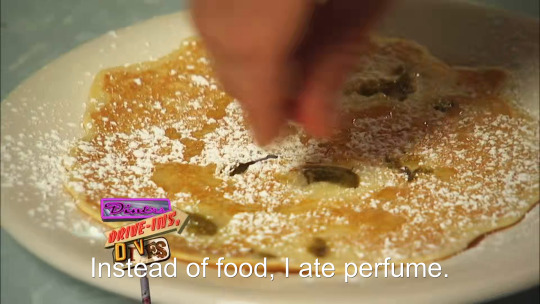
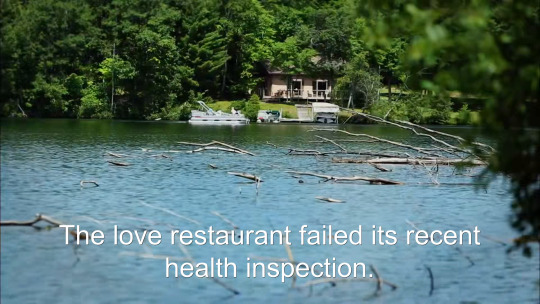









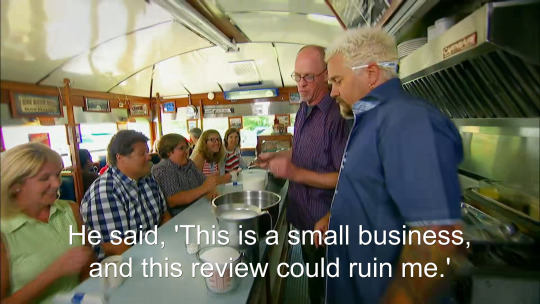

[I made a reservation at the restaurant of love. Where they only have tables for two. Instead of taking my order, the waiter gave me a kiss. Instead of food, I ate perfume. The love restaurant failed its recent health inspection. Because the kitchen is infested with rats. I'm not talking love rats; these are regular rats. And they're biting all the customers and staff. I got food poisoning at the love restaurant. Pretty sure it was caused by the rats. I posted a one-heart review on Yelp.com/love. Then the business owner contacted me privately. He said, 'Why'd you give my restaurant a one-heart review?' I said, 'Because it was full of rats.' He said, 'This is a small business, and this review could ruin me.' He cried over the phone and said he was trying his best.]
#s21e07 old school joints#guy fieri#guyfieri#diners drive-ins and dives#recent health inspection#business owner#small business#one-heart review#food poisoning#regular rats#love restaurant#love rats#reservation#tables#order#waiter#kiss#perfume#the#kitchen#customers#staff#yelp#phone
506 notes
·
View notes
Text


Summer in the city's south: terraced back gardens, a martini with an olive, f's tomatoes eaten fresh from the vine, aranchino the cat rolling in the sun, embroidering the tablecloth on a whim, splitting a cake with the neighbours, dappled shadows across thighs
#summer#diary#home#photography#sunlight#tables#tablescapes#cat#exteriors#architecture#places#london#south london
782 notes
·
View notes
Text
1d12 ways to complicate an encounter
A magic or mundane artifact generates an effect harmful to the PCs, but it is guarded by the monster's minions.
The encounter's setting starts to collapse during the battle, and all the combatants will need to escape.
A boss monster has a 'second form' that activates mid-way through the battle.
Traps are placed throughout the battlefield, and characters must be wary of them.
The PCs must complete a ritual while fending off attacks from the enemy.
The encounter area is a series of cliffs or platforms, forcing characters to jump around and risk falling, possibly into a pit, water, or lava.
There is a monster that uses the blink spell or tunneling to avoid attacks between its turns.
A minor enemy has the ability to summon or call for reinforcements every round.
There are three sides, not two, battling in this encounter.
A disastrous environmental effect, such as an avalanche, wildfire, or earthquake, occurs in the area, dealing damage and forcing the combatants apart.
An anti-magic pulse affects some areas of the battlefield periodically, suppressing spells and magical items when it is active.
The enemies are shockingly weak and easily defeated, but the PCs' goal isn't here -- the treasure chest is a mimic, or their princess is in another castle.
585 notes
·
View notes
Text

Greece (by Vladan)
345 notes
·
View notes
Note
Hi Jacky, I'm in desperate need of large dining tables for bigger families or groups of sims, and wanted to ask if you could maybe convert the square 3x2 dining table and the 5x1 dining table (the normal one, not the wider one) from this set by simverses here on tumblr:
/simverses/670386752109871104/winterfest-day-12-place-settings-default
and the 5x1 dining table from this set:
/simverses/670174433166671872/winterfest-day-10-sda-castle-livingroom
Thank you so much if you can do this and for all the other wonderful creations you have shared with us <3
Ingeli Classic Dining 3x2 and 5x1 - Medieval Living Room DiningTable 5x1 - for The Sims 2

These are 4to2 conversions from Simverses, low poly. They are big tables, one is 3x2 tiles wile the other two are 5x1, they are functional. A bunch of recolors are included.
DOWNLOAD HERE
-------------------------------
If you want to support my creations, you can send me a donation with Paypal or Ko-fi ☕ If you want to ask for a Paid Commission, HERE you can find more details. Thank you ❤️
#ts2#the sims 2#sims 2 cc#sims 2 download#the sims 2 cc#ts2 download#4to2#4to2 conversion#buy mode#tables#dining table#functional#medieval
162 notes
·
View notes
Photo

Best Designer Home Decor Dupes for 2024 - Room for Tuesday
#tables#runners#entertaining#cozy aesthetic#dining rooms#decorating#throws#dishes#glassware#glass tabletops
374 notes
·
View notes
Text

#This Very Impratical Table#real life#tables#adoption poll#image submitted#no tags submitted#might be good for having dinner with characters you don't like lol
278 notes
·
View notes
Text
Silmarillion Survey Essay!
My essay was due last night (submitted it with 6 minutes to spare!) and my professor said I could post it to Tumblr if I wanted to. It's divided into four sections, all marked. The first section is the introduction where I explain the point of the survey, who I studied, and why. The second section is the methods I used to design the survey, get answers, record answers, and control for variables. The third section is results, where I highlight several of the questions I thought would be most stratifying and explain what I actually found (it has graphs!). The fourth section is the discussion where I talk about what I found and what conclusions I drew from that.
I'd love to hear all of your thoughts on the results and my conclusions!
Introduction
For this project, I looked into age (and length of time in fandom, in one case) affected knowledge and attitudes about fandom language. I investigated several terms and phrases, both from fandom at large and from the Silmarillion fandom specifically. The group I studied was the fandom of The Silmarillion on Tumblr because I am intimately familiar with that internet space (and could therefore phrase the questions in a way that would be understood) and because the majority of Archiveofourown.org (a popular fanfiction website) users are also Tumblr users.
For the purposes of this paper, I am defining the Silmarillion fandom as a community of practice. The Wenger-Trayner article, “Communities of practice a brief introduction”, defines a community of practice as an entity with three parts: domain, community, and practice. The domain is “an identity defined by a shared domain of interest” (Wenger-Trayner 2). The domain in this case is The Silmarillion. As The Silmarillion is a history book set in a fictional universe, it is incredibly dry at times (there is an entire chapter titled “Of Beleriand and its Realms” which deals mostly with geography) so anyone who reads it by choice is necessarily interested in the work. The second part, community, is made up of “members [that] engage in joint activities and discussions, help each other, and share information” (Wenger-Trayner 2). Most fandoms engage in discourse/discussion, create transformative art (mostly written or visual, but I have seen musical as well) and exchange craft advice to better each other’s creative work, but due to the almost academic nature of the Silmarillion fandom, we exchange background lore knowledge, additions to Tolkien’s conlangs, translations, timelines, and character sheets in addition to the regular fandom activities. Finally, the Silmarillion fandom also has a shared practice, defined as “They develop a shared repertoire of resources: experiences, stories, tools, ways of addressing recurring problems—in short a shared practice” (Wenger-Trayner 2). As mentioned above, the Silmarillion fandom has shared resources (such as tolkiengateway.net, Nerd of the Rings on YouTube, as well as several established “fandom elders” who are happy to answer questions), stories, established characterizations for “only-mentioned-once-in-a-footnote” type characters, settled linguistic debates, and several research-oriented blogs (such as two of my own) that record niche or new knowledge about either Tolkien’s work or the fandom itself. Almost all of the above (with the possible exception of the website and the youtuber previously mentioned) is unpaid hobby work.
When doing this survey, I expected to find a rather steep difference between older and younger members of fandom regarding their knowledge of fandom terminology. I expected the 18-25 age group to be the most knowledgeable of fandom terms with the under 18 group to be only slightly behind them and the 26-30 group a slightly further way behind the under 18 group. For the groups over 30, I anticipated that the rate of knowledge would sharply decline and that older fans would be unfamiliar with fandom terminology for the most part. I was… incorrect.
Methods
There are eight questions highlighted in this paper. The first chart (Figure 1.) is the total percentage of answers that amounted to “I don’t know”, filtered by age. The first table (Figure 2.) looks at the people who did not know the term “Isekai” based on whether or not they were native speakers of English or live in Asia (given that “Isekai” is a Japanese word). The second table (Figure 3.) compares the percentage of people who mentioned that the word “angst” is also present in everyday German, categorized by German speakers and non-German speakers. The third table (Figure 4.) examines attitudes towards the anti/pro-ship terms based on age. The second chart (Figure 5.) examines attitudes towards the term “omegaverse” separated by age. The fourth table (Figure 6.) compares groups of people who could define the difference between “peredhel” and “peredhil”, separated by how long they have participated in the fandom surrounding the Silmarillion fandom. The third chart (Figure 7a.) looks at people who understand the phrase “Fëanor did nothing wrong” as a joke, filtered by age. Finally, the fourth chart (Figure 7b.) shows the percentage of people who used the phrase “tongue-in-cheek” in the 31-40 group as opposed to other age groups (that one was not explicitly asked for in the survey; I simply noticed a steep trend while dissecting the results from the “Fëanor did nothing wrong” question).
I compiled all of these questions (along with several others) in a google form as a three-part survey. The first part was comprised of basic demographic questions, the second of general fandom terms and phrases, and the third of terms and phrases specific to fanfiction of The Silmarillion. The 418 responses were recorded and examined in Google sheets, which I used to filter the demographic information for ease of synthetization.
The group I examined was people who participate in the Silmarillion fandom on Tumblr. I chose this group because I am familiar with them, because they are the most likely to be aware of these terms (due to the large overlap between Tumblr and Archive Of Our Own), and because fandom language is (to the best of my knowledge) not well studied. I was able to isolate this group by only posting the survey to Tumblr itself. Tumblr posts are only viewable to Tumblr users, so even if someone were to post a link to the post elsewhere, the only people able to access the survey would be Tumblr users. I further attempted to control by including several fandom related and The Silmarillion-specific questions in the demographic portion of the survey. Anyone who completed the demographic portion would have been well aware of the nature of the survey by the end, regardless of how poorly they understood the original survey posting. These measures, of course, did not stop everyone. I had a few respondents who submitted only the demographic portion or the demographic and general fandom portions. Luckily, due to the Google Sheets functions, such responses were relatively easy to filter out.
Results

(Figure 1. A chart observing, out of all 16,065 answers, how many equate to “I don’t know?” Under 18: 14.24%, 18-25: 5.9%, 26-30: 7.43%, 31-40: 9.17%, 41-50: 13.63%, 51-60: 7.3%, 61-70: 9.7%)

(Figure 2. A table comparing different categories of people and what percentage of them are unfamiliar with the term “Isekai”; a Japanese term which is most commonly defined as “a trope in which a character somehow travels from the mundane ‘real’ universe into a fictional one.” 23.08% of native English speakers are unfamiliar with the term. 27.07% of non-native English speakers are unfamiliar with the term. 20% of respondents who live in Asia are unfamiliar with the term.)

(Figure 3. A table comparing different categories who mention that “Angst” (defined in fandom context as “dramatic, serious, and sometimes dark”) is an everyday word in German. 12.73% of German speakers mentioned it. 1.38% of people who either do not speak German, or did not mention it in their language background, mentioned it.)

(Figure 4. A table comparing the attitudes of different age groups to the terms “anti-ship” and “pro-ship”. These terms are hotly debated in fandom. Those on the anti side of the debate define anti-ship as “being morally against abuse and pedophilia,” and pro-ship as “excusing abuse and pedophilia in fandom.” Those on the pro side of the debate define anti-ship as “puritanical and chronically online people who can’t separate reality and fiction” and pro-ship as “letting people ship whatever they want and separating reality from fiction.” Those under 18 are 4% anti, 4% pro, and 92% neutral. Those from 18-25 are 2.44% anti, 29.27% pro, and 68.29% neutral. Those from 26-30 are 0% anti, 33.67% pro, and 66.33% neutral. Those from 31-40 are 2.2% anti, 26.37% pro, and 71.43% neutral. Those from 41-50 are 0% anti, 46.15% pro, and 53.85% neutral. Those from 51-60 are 12.5% anti, 37.5% anti, and 50% neutral. Those from 61-70 are 0% anti, 50% pro, and 50% neutral (although, admittedly, there are only two respondents in that group.))
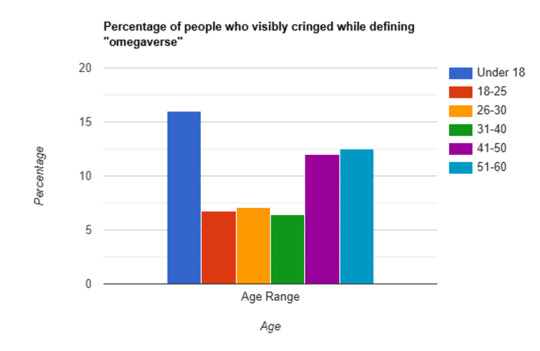
(Figure 5. A chart that shows the rate at which respondents cringed (using phrases such as “please don’t make me define this,” “oh god,” and “Nuh uh. Sorry man. Sweet baby rays good lord.”*) within their responses while defining “Omegaverse” (an erotica subgenre within fandom based on outdated wolfpack dynamics. Very popular, but also very taboo). Under 18: 16%, 18-25: 6.71% 26-30: 7.07%, 31-40: 6.45%, 41-50: 12%, 51-60: 12.5%)
*All real responses I received
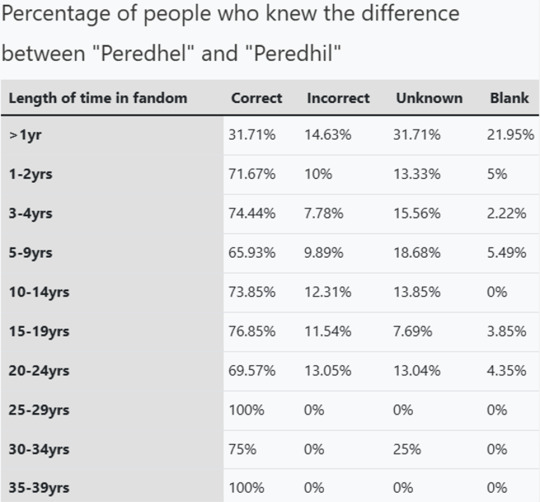
(Figure 6: A chart exploring the differences between who can correctly identify the difference between the terms “peredhel” (half-elf, singular) and “peredhil” (half-elves, plural) based on how long they have been in the fandom. Those who have been in the fandom for less than a year are 31.71% correct and 14.63% incorrect. Those who have been in the fandom for 1-2 years are 71.67% correct and 10% incorrect. Those who have been in the fandom for 3-4 years are 74.44% correct and 7.78% incorrect. Those who have been in the fandom for 5-9 years are 65.93% correct and 9.89% incorrect. Those who have been in the fandom for 10-14 years are 73.85% correct and 12.31% incorrect. Those who have been in the fandom for 15-19 years are 76.92% correct and 11.59% incorrect. Those who have been in the fandom for 20-24 years are 69.57% correct and 13.04% incorrect. Those who have been in the fandom for 25-29 years are 100% correct and 0% incorrect. Those who have been in the fandom for 30-34 years are 75% correct and 0% incorrect. Those who have been in the fandom for 35-39 years are 100% correct and 0% incorrect.)
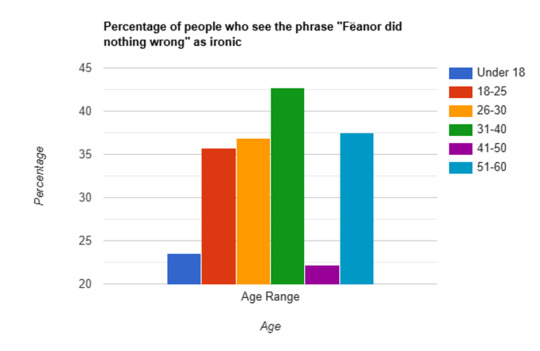
(Figure 7a. A chart observing who sees the phrase “Fëanor did nothing wrong as ironic” divided by age. Under 18: 23.53%, 18-25: 35.77%, 26-30: 36.9%, 31-40: 42.67%, 41-50: 22.22%, 51-60: 37.5%)
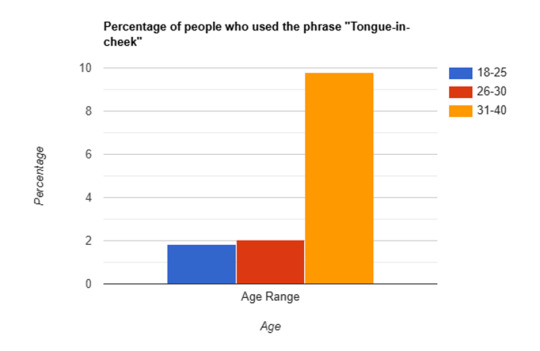
(Figure 7b. A chart observing the percentages of age groups who used the phrase “tongue-in-cheek” while answering the above question. 18-25: 1.84%, 26-30: 2.04%, 31-40: 9.78)
Discussion
Observing these results, I can see that, while there is some level of stratification by age and length of time spent in the fandom, it is not nearly as dramatic as I had expected it to be. These results strongly demonstrate the power of communities of practice. These people, across ages and continents, communicate so often and so deeply, that nearly all terms are understood to the same degree by everyone, and nearly everyone has similar stances on divisive pan-fandom debates.
Were I to do this study again, or a similar study in the future, I would probably narrow the purview by a lot. I would ask fewer questions (or at least, only ask questions of a single type), compare them against only one demographic question, and sincerely consider making them multiple choice. That being said, I do not regret this survey having short answer questions. There were several definitions of several terms that I never could have come up with in a million years. Synthesizing the short answers may have taken more effort on my part, but I learned a lot about my fandom.
@proship-anti-discussion (ship debate was mentioned)
#silmarillion#fandom#linguistics#survey says#silmarillion survey#fandom survey#academia#nerd shit#graphs#charts#tables#isekai#angst#antishiping#proshipping#omegaverse#peredhel#peredhil#feanor#fëanor#fëanor did nothing wrong#fandom discourse#fandom meta
81 notes
·
View notes
Text
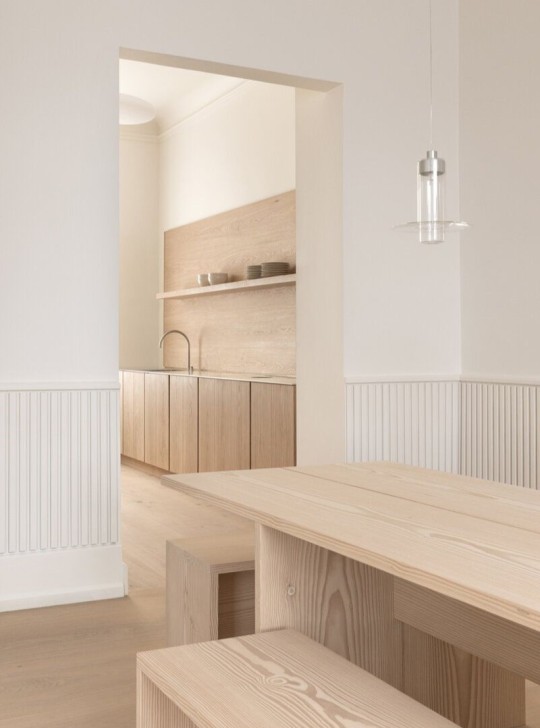




dinesen apartment ~ john pawson | photos © monica steffensen
#architecture#interiors#interior design#furniture#tables#bench#kitchens#dining#living#old and new#minimal#simple#quiet#wainscot#flooring
179 notes
·
View notes
Text

Photo originale par Steph-Photo
un coin bien tranquille au bord du Lac de Serre-Ponçon
#original photographers#steph photo#french photographer#original post#photographers on tumblr#france#insolite#leica q3#lac#lac de serre-ponçon#hautes alpes#noir et blanc#black and white photography#black and white#mobilier urbain#banc#tables
63 notes
·
View notes
Text

Life is beautiful
379 notes
·
View notes
Text

Reading of the Will by Otto Erdmann
#otto erdmann#art#rococo#reading#will#furniture#georgian era#georgia#history#aristocracy#aristocrats#aristocratic#europe#european#room#rooms#chest#vase#painting#decor#clock#tables#chairs#outifts#clothing#clothes#casket#box
66 notes
·
View notes

